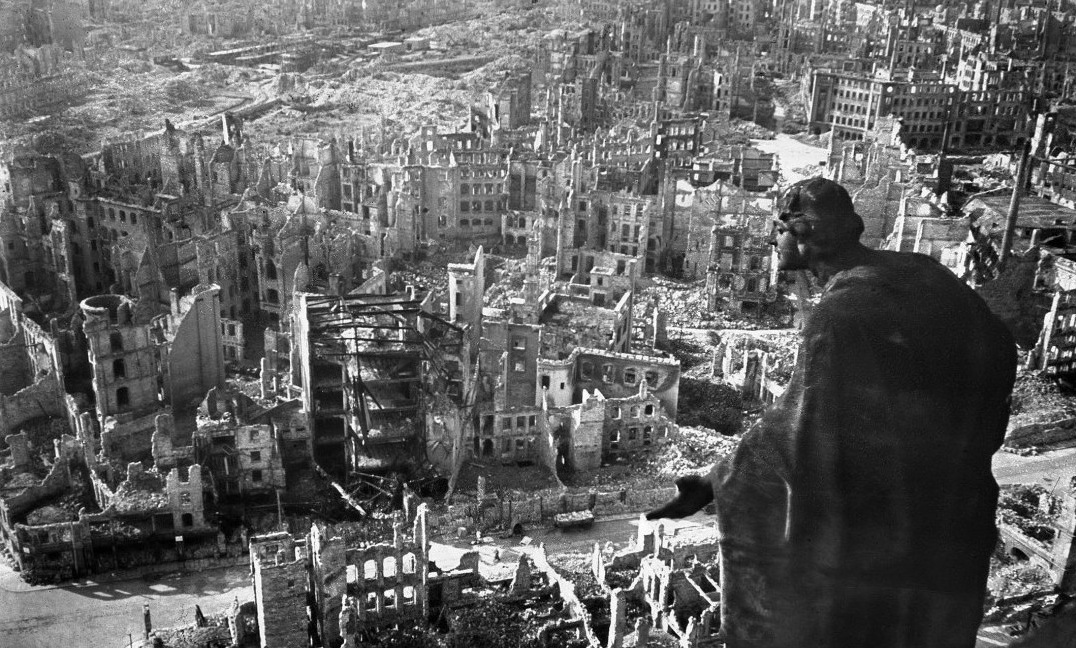
.
Fire bombing of Dresden was one of the most controversial actions of the Second World War:. Between 13 February and 15 February 1945 (twelve weeks before the final capitulation of Germany), 3,900 tons of high-explosives and incendiary devices were delivered in four air raids carried out by 1,300 bombers. Thirteen square miles of the city and the estimates of civilian dead vary from 100,000 to 130,000 — twice the amount that perished during the entire London Blitz. Nearly a thousand invaluable masterpieces (mainly from Gemäldegalerie Alte Meister) were lost or destroyed.
After the war, it was common practice by the photographers to illustration the city’s devastation from atop the cityhall tower, Rathaustrum. The rubble-strewn landscape appeared in various photos by Ernst Schmidt, W. Hahn, Willi Rossner, Hilmar Pabel and many other photographers. What made the photo above by Richard Peter sen. unique was that other photographers shot the photos of the devastation beyond sixteen larger-than-life sandstone figures that ringed the tower. Peter, however, included one of the figures in his photo and juxtaposed it.
Peter remembered that he had to climb up the tower three times:
Rubble, ruins, burnt-out debris as far as the eye can see. To comprise the totality of this barbaric destruction in a single picture seemed at most a vague possibility. It could be done only from a bird’s eye view. But the stairs to almost all the towers were burned out or blocked. In spite of the ubiquitous signs warning ‘Danger of Collapse,’ I nonetheless ascended most of them – and finally, one afternoon, the City Hall Tower itself. But on that day, the light was from absolutely the wrong direction, thus making it impossible to take a photograph.
The next day I climbed up again, and while inspecting the tower platform, discovered an approximately ten-foot-high stone figure – which could not in any way be drawn into the picture, however. The only window which might have offered the possibility for this was located around 13 feet above the platform, reachable only from inside the tower.
Two stories down, I found a 16-foot stepladder that someone may have carried up after the fire to assess the extent of the damage. The iron stairway was still in good repair. How I managed to get that murderous ladder up the two stories remains a riddle to this day. But now I was standing high enough over the figure and the width of the window also allowed the necessary distance. The series of exposures made with a Leica, however, resulted in such plunging lines, that the photographs were almost unusable. In this case only a quadratic camera could help, but I didn’t own one.
After two days, I finally hunted one down, climbed the endless tower stairs for the third time, and thus created the photograph with the accusatory gesture of the stone figure — after a week of drudgery effort and scurrying about.”

.
Commonly mistaken as an angel, the statue was actually Bonitas, a personification of Kindness. It had once overlooked a magnificent city, so-called ‘Florence-on-the-Elbe’, the former seat of the Electors of Saxony. Now beyond its outstretched arms was a sea of ruins. Peter included the photo in his detailed record of the city’s ruins — Dresden, eine Kamera klagt an (Dresden, a camera accuses) — 50,000 copies of which was published, an astonishing large printrun for the time. For Peter, the loss was personal: the Nazis had banned him from practicing photography due to his Communist sympathies in 1933, and his pre-1933 archives were lost in the firebombing of the city.
The decision to bomb the city brimming with refuges fleeing from the advancing Red Army was approved by the very top brass and was keep so secret that the airmen were under the impression that they were bombing the army headquarters, barracks, and poison gas plants. In fact, Dresden had no war industry. The strategy too was cynical and iniquitous: since bomb shelters could provide protection for only three hours in a burning city (due to overheated grounds and walls), the second attack was launched precisely at the moment when everyone had to go back outside.

.
Peter’s book also has two other photographs that were notable — of bodies unearthed from the cellars in which they had been entombed. Top right, on the left hand page, the body of long haired woman, facial features still partly discernable; opposite page, a corpse wearing a swastika armband. They were reminiscent of ancient tombs: preserved clothes, bones and hair. Top left, facing the picture of a museum skeleton, shown in silhouette against the ruins, was the photo of a wall where the living chalked their messages looking for their dead relatives. One read, “Mother, we’re trying to find you.” Peter’s book was banned by East Germany’s socialist rulers not long after it had been published, and not republished again until 1980.
Many newspapers toed the official line that Dresden was a major military target; when the AP reported, “Allied air chiefs have made the long-awaited decision to adopt deliberate terror bombings of German population centers as a ruthless expedient of hastening Hitler’s doom”, the British government banned its report. It was three more weeks before the Manchester Guardian published an account revealing many civilians died in a horrifying manner.
In a twisted irony, two hideous atrocities of the Second World War met in this ‘Balcony of Europe’: the cremation of the dead in Dresden was supervised by SS Sturmbahnfuhrer Karl Streibel, the man who made his name burning bodies at the Treblinka death camp. A funeral pyre at Dresden burnt for five whole weeks.






